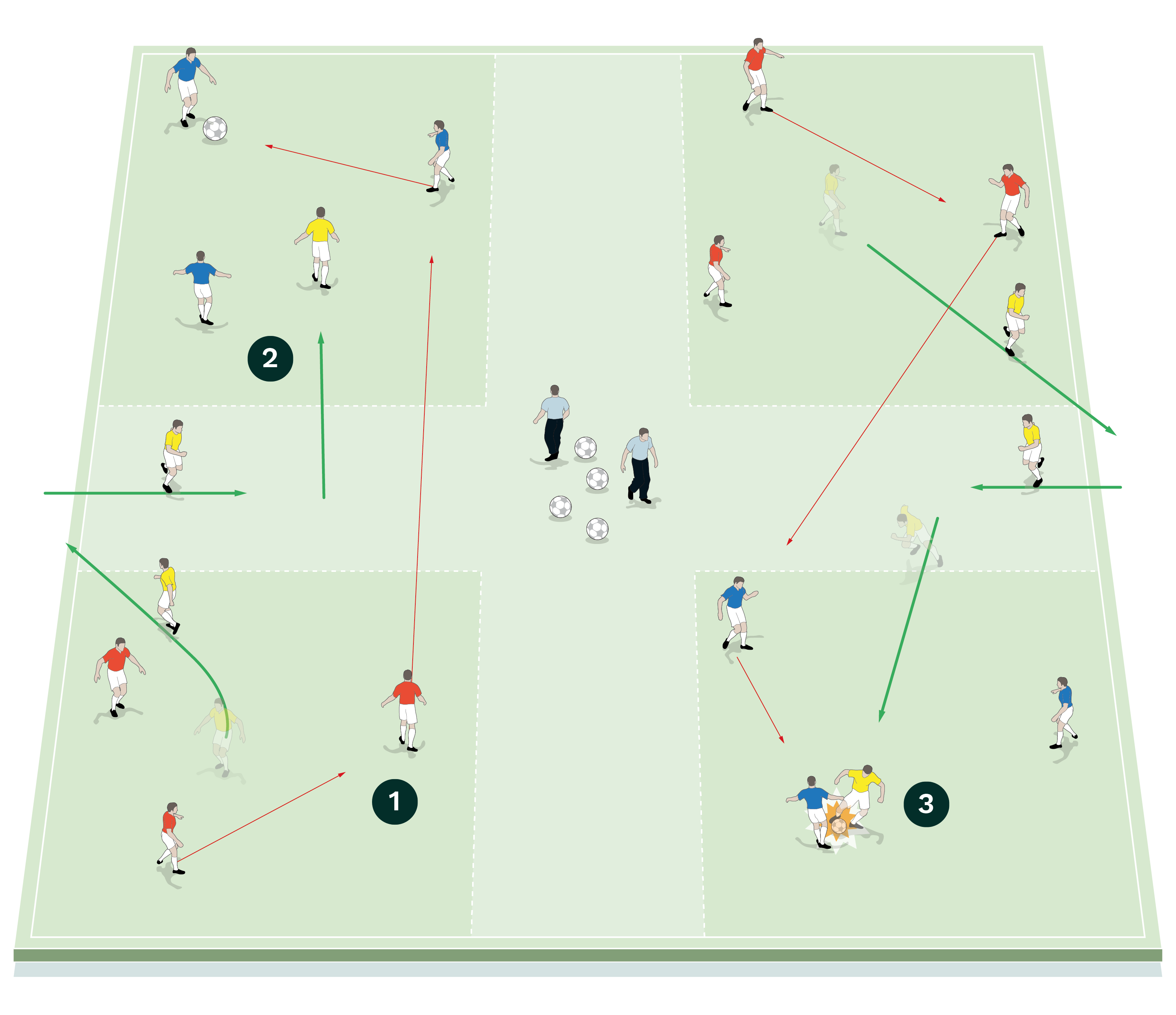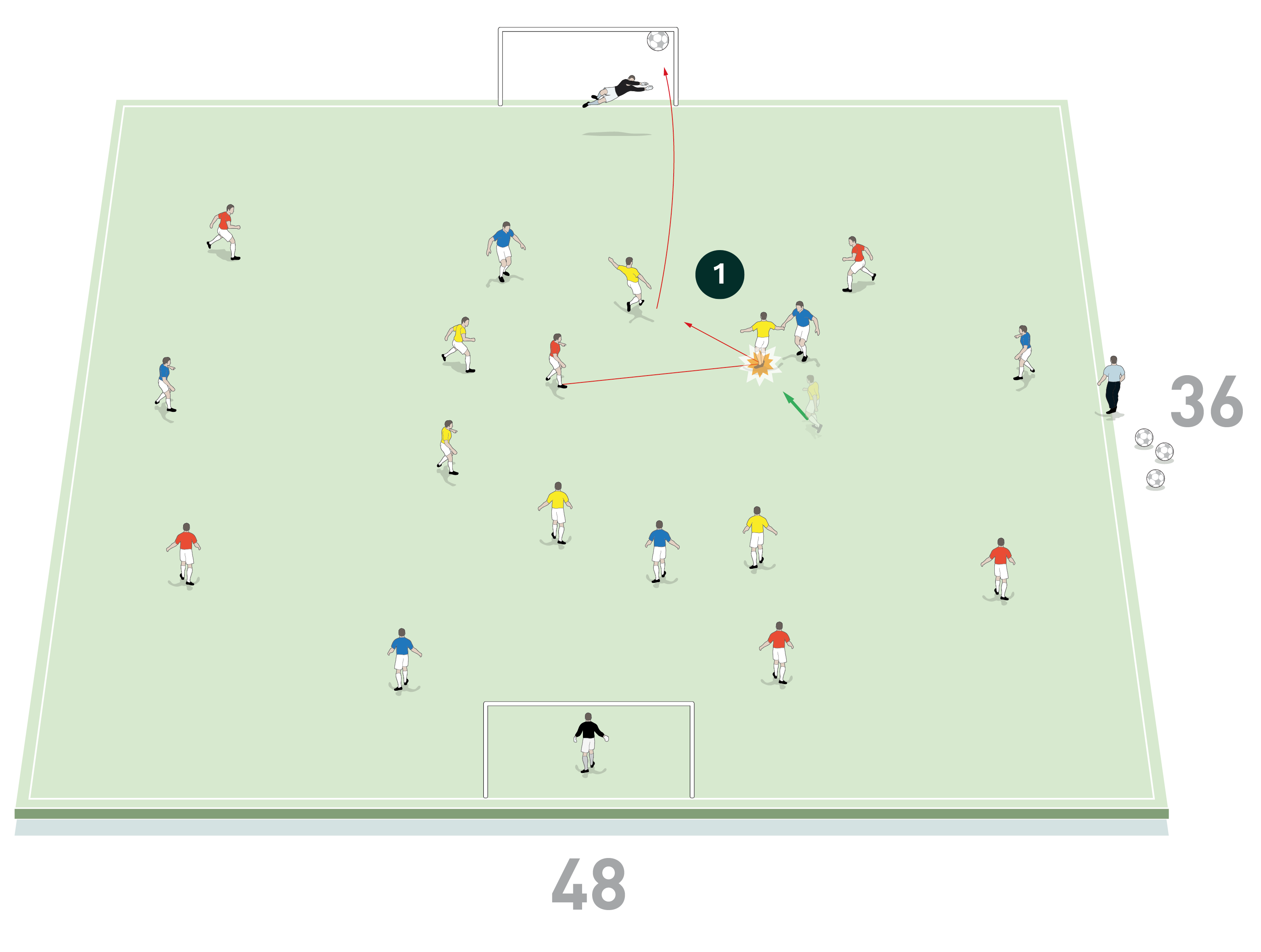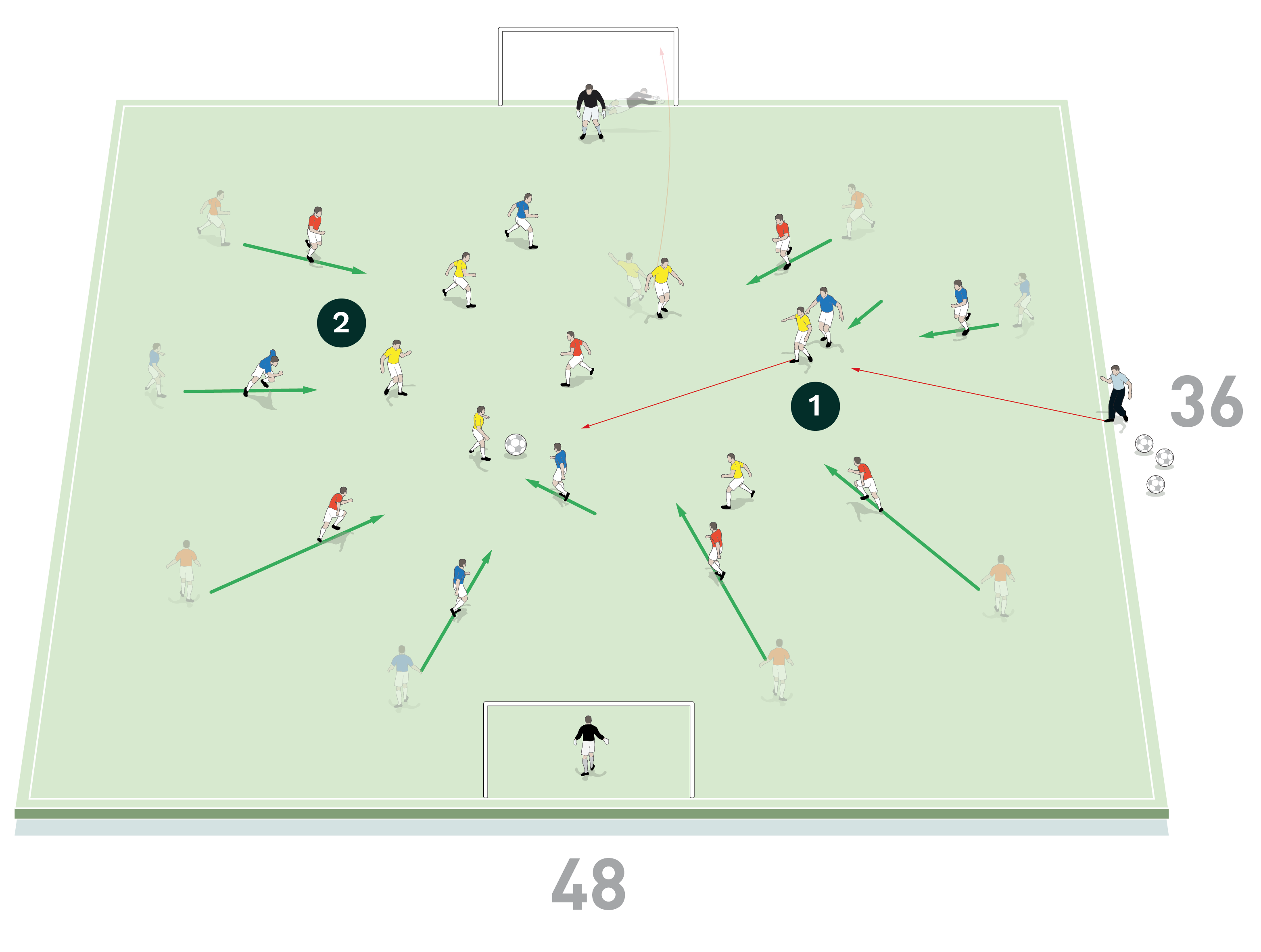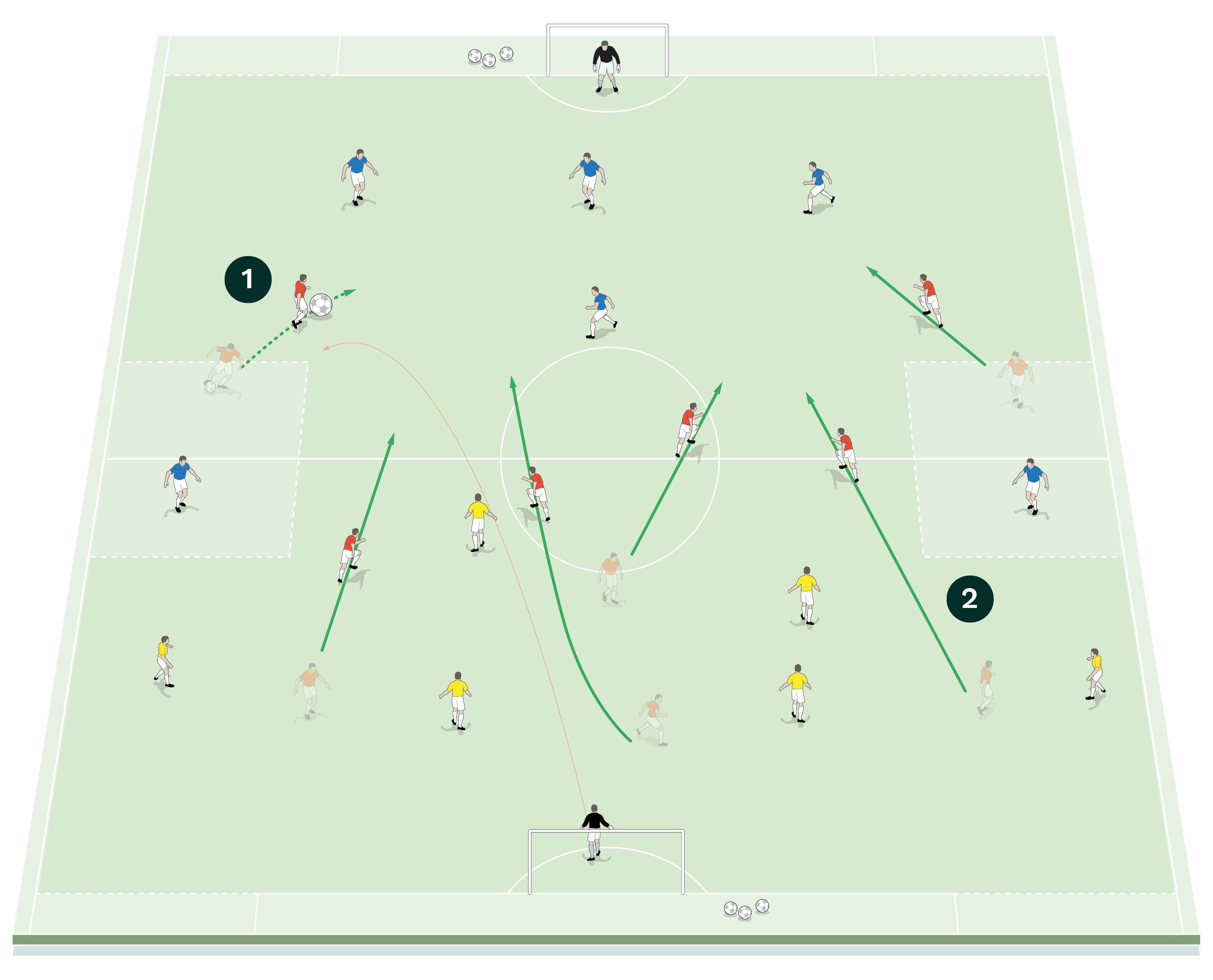




OUR BEST EVER OFFER - SAVE £100/$100
JOIN THE WORLD'S LEADING PROFESSIONAL DEVELOPMENT PROGRAMME
- 12 months membership of Elite Soccer
- Print copy of Elite Player & Coach Development
- Print copy of The Training Ground
You are viewing 1 of your 1 free articles
Defending and the transition to counter-attack
| Area | Up to three quarters of pitch |
| Equipment | Balls, bibs, cones, 2 full size goals |
| No. of Players | Up to 18 players + 2 goalkeepers |
| Session Time | Possession and defending: 15-20mins Possession with transition: 15-20mins Transition to counter-attack: 15-20mins |
These activities are designed to move the ball with speed and quality along with getting players to transition quickly into counter-attacks. They also focus on encouraging players to be more clinical in front of goal. The session comprises of a small possession game, a possession game with a transition that concludes with a variety of finishing, and a counter-attacking wave game that starts with a transition.
We have chosen these sessions to simulate the competitive edge of a match day in training. The players will be in three teams of six, competing against each other throughout the session, keeping the energy high tempo. All the activities are built around our playing principles, with the intention that the players will implement this information on a match day when faced with similar situations.
Sessions of this intensity are normally carried out at the start of the week dependent on the match schedule. With it being a high tempo session, we would run it on a Tuesday if there is no game until the Saturday, giving players Wednesday as a recovery day.
Area sizes can vary depending on group size and how hard you want the group to work. These types of sessions would be done weekly unless there is a midweek match.
“All the activities are built around our playing principles, with the intention that the players implement this information on a match day when faced with similar situations”
POSSESSION AND DEFENDING
We set up a playing area of 20x20 yards, comprising of four 8x8-yard boxes separated by a four-yard gap. We’re using 18 outfield players split into three teams of six, who play a competitive possession game. The reds start with their players split evenly across two boxes diagonally apart, as do the blues – these are the possession teams. The yellows are the defending team and they start with four players in the central gap between the boxes and two on the outside of the area.
The coaches start play by serving a ball into each of the red boxes. As soon as the balls have been received, one yellow defender can enter each of the active boxes to press, making it 3v1 in each of the boxes. The aim for the possession team is to pass a ball in the box and keep hold of possession under pressure from the yellow defender, as shown [1a].
[1a]

2. As soon as the ball has been received, one yellow defender can enter each of the boxes to press, making it a 3v1 in each of the two active boxes
3. The possession teams are limited to two-touch
[1b]

2. When the reds successfully transfer a ball, the yellow defenders rotate in and out, so there is always one defender pressing in each box
3. The defender only needs to touch the ball to score a point. Then that player rotates out and another defender moves into opposite box where the coach will restart play
The possession teams are limited to two-touch and they must try to string six consecutive passes together in the box before they can transfer the ball to the rival possession team in the opposite box, as shown [1b]. When the possession teams successfully manage to transfer a ball, the yellow defenders rotate in and out, so there is always one defender pressing in each of the two active possession boxes.
The defender only needs to get a touch on the ball to score a point. Once a defending player has touched the ball, that player moves out and a team-mate moves into the opposite box where the coach restarts the exercise with a new ball.
We play two two-minute rounds with a one minute break before rotating the teams so each team has a turn in the defending role. We play for 15-20 minutes and the defending team with the most touches at the end of session wins the competition.
POSSESSION WITH TRANSITION
We set up a playing area of 36x48 yards with a full size goal and a goalkeeper at each end. We’re using 18 outfield players split into three teams of six.
The coach starts play by serving a ball into the possession players. Two of the teams (the blues and the reds) work together to keep hold of the ball for as long as possible under pressure from the third team (the yellows), as shown [2a].
The possession teams are limited to three-touch, while the pressing team have unlimited touches.
[2a]

2. The blues and the reds work together to keep hold of the ball. The two possession teams are limited to three-touch
3. The yellows must press intensely and should try to win possession. They are allowed unlimited touches
“If the defending team wins possession, they can immediately transition and must try to score by attacking either goal”
[2b]

[2c]

2. The blues and the reds must react quickly to any transition by pressing aggressively to win the ball back. If they succeed, they must pass to keep possession until time is up
If the defending team wins possession, they can immediately transition and must try to score by attacking either goal, as shown [2b].
If the yellow defending team scores a goal, the coach will serve a new ball to the yellow team and they must try to score again. The 12 players who were originally in possession (the blues and the reds) need to react quickly to any transition by pressing aggressively to win the ball back, as shown [2c]. If they succeed in regaining the ball they must then try to keep possession until the allocated time has finished.
We rotate teams so all the players get the opportunity to close down and score. We play for 15-20 minutes with each team pressing for one three-minute game and one two-minute game, with one minute’s rest in-between.
At the end of the session, the winner is the pressing team that has scored the most goals.
TRANSITION TO COUNTER-ATTACK WAVE GAME
[3a]

2. Four of the blues start as defenders at the top end of the playing area
3. Two players from each defending team start locked in wide boxes on the halfway line
4. Four of the reds start as defenders at the bottom end of the playing area
[3b]

2. If the yellow attacking team misses, or if the shot is saved, as here, then the keeper can deliver a ball to one of the waiting red players on the halfway line
We set up a playing area between the penalty boxes using the full width of the pitch and with a full size goal and a goalkeeper at each end. We’re using 18 outfield players split into three teams of six.
The yellows are the attacking team, while four of the reds defend one end and four of the blues defend the other end. Two of the blues and two of the reds are locked into wide boxes marked out on either side of the halfway line, as shown.
The goalkeeper starts play by throwing the ball out to a player from the yellow attacking team of six, who has dropped into the opposite half to receive, as shown [3a]. The six yellow players then attack the goal defended by the four red players with the aim of trying to take advantage of their 6v4 overload to score.
If the yellow attacking team scores, then the red defending team stays where it is and the yellow counter-attack now changes direction towards the opposite end, but if the yellow attacking team misses the target, or if the goalkeeper saves the shot, then the goalkeeper can deliver the ball to one of the two waiting red players on the halfway line, as shown [3b].
[3c]

2. The four red defenders must react to the transition and join the counter-attack in a new 6v4 attacking situation
[3d]

2. Two yellow players replace the two reds in the wide boxes on the halfway line
Both of the waiting reds can now break out of their wide boxes to counter-attack the goal at the top end defended by the blues. They are supported by the four red defenders, who must react and join the counter-attack in a new 6v4 attacking situation, as shown [3c].
The yellow team that launched the first attack now replaces the reds as the defending team at the bottom end, with two yellow players going to the wide boxes on the halfway line, as shown [3d].
If the four blues are successful in defending against the red counter-attack and manage to win the ball, they can break out of their half by playing a forward pass into the path of either of their two waiting players on the halfway line and then the blues counter-attack against the goal now defended by the four yellows, as shown [3e].
We play three four-minute rounds with two minutes of rest after each round. We play for 15-20 minutes.
[3e]

2. One of the wide blue players receives the forward pass and dribbles out of the box to counter-attack
The remaining blues must react quickly to the transition and support the counter-attack against the yellows
“When attacking we want to see positive and clinical finishing. When defending, we expect the players to be aggressive”
COACHING POINTS
What are the key things to look for?
Within the session we look for the players to have good communication and concentration, quality with the ball, a quick speed of passing and clever movements. They should also be able to demonstrate composure on the ball.
When attacking we want to see positive and clinical finishing. When defending and in transitions, we expect the players to be aggressive and have a good work ethic – individually and as a team.
What are the typical mistakes players might make and how do I avoid them?
Mistakes will happen throughout the session. These can be due to a variety of reasons: fatigue, a lack of concentration, misplaced passes, and erratic finishing. We would encourage players to keep motivated when mistakes happen. However, if players keep making the same mistakes, the session would be halted and we would ensure the group understand the session objectives.
We try to get players to overcome mistakes by keeping the energy high with encouragement, positivity and extra practice.
Related Files
Editor's Picks
Attacking transitions
Deep runs in the final third
Using the goalkeeper in build-up play
Intensive boxes drill with goals
Penetrating the final third
Creating and finishing
My philosophy
Pressing initiation
Compact team movement
Coaches' Testimonials

Alan Pardew

Arsène Wenger

Brendan Rodgers

Carlos Carvalhal

José Mourinho

Jürgen Klopp

Pep Guardiola

Roy Hodgson

Sir Alex Ferguson

Steven Gerrard
Coaches' Testimonials

Gerald Kearney, Downtown Las Vegas Soccer Club

Paul Butler, Florida, USA

Rick Shields, Springboro, USA

Tony Green, Pierrefonds Titans, Quebec, Canada
Join the world's leading coaches and managers and discover for yourself one of the best kept secrets in coaching. No other training tool on the planet is written or read by the calibre of names you’ll find in Elite Soccer.
In a recent survey 92% of subscribers said Elite Soccer makes them more confident, 89% said it makes them a more effective coach and 91% said it makes them more inspired.
Get Monthly Inspiration
All the latest techniques and approaches
Since 2010 Elite Soccer has given subscribers exclusive insight into the training ground practices of the world’s best coaches. Published in partnership with the League Managers Association we have unparalleled access to the leading lights in the English leagues, as well as a host of international managers.
Elite Soccer exclusively features sessions written by the coaches themselves. There are no observed sessions and no sessions “in the style of”, just first-hand advice delivered direct to you from the coach.







